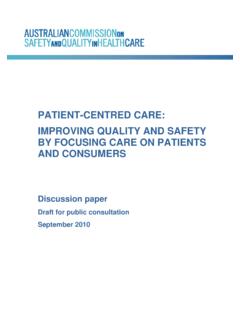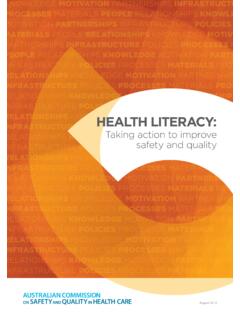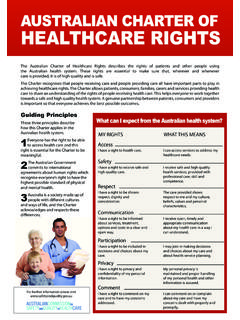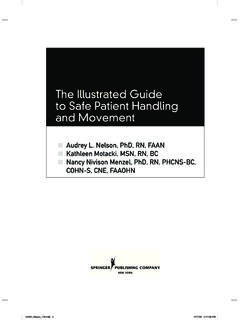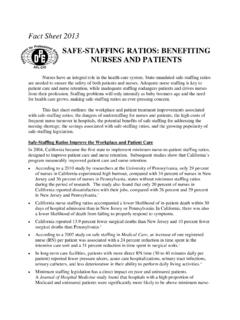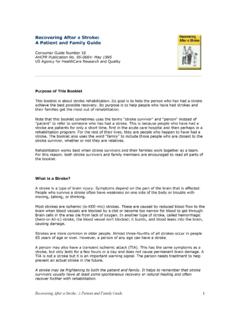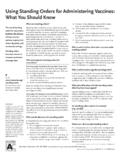Transcription of Safety and Quality Improvement Guide Standard 4 ...
1 4444444 October 2012 Standard 4 Medication SafetySafety and Quality Improvement GuideISBN: Print: 978-1-921983-33-7 Electronic: 978-1-921983-34-4 Suggested citation: Australian Commission on Safety and Quality in Health Care. Safety and Quality Improvement Guide Standard 4: Medication Safety (October 2012). Sydney. ACSQHC, 2012. Commonwealth of Australia 2012 This work is copyright. It may be reproduced in whole or in part for study or training purposes subject to the inclusion of an acknowledgement of the source.
2 Requests and inquiries concerning reproduction and rights for purposes other than those indicated above requires the written permission of the Australian Commission on Safety and Quality in Health Care:Australian Commission on Safety and Quality in Health CareGPO Box 5480 Sydney NSW 2001 Email: document was prepared by the Australian Commission on Safety and Quality in Health Care in collaboration with numerous expert working groups, members of the Commission s standing committees and individuals who generously gave of their time and Commission wishes to acknowledge the work of its staff in the development of this of ContentsThe National Safety and Quality Health Service Standards 2 Terms and definitions 5 Standard 4.
3 Medication Safety 7 Criterion: Governance and systems for medication Safety 8 Criterion: Documentation of patient information 31 Criterion: Medication management processes 42 Criterion: Continuity of medication management 60 Criterion: Communicating with patients and carers 69 References 77 Appendix: Links to resources 78 Standard 4.
4 Medication Safety2 | Australian Commission on Safety and Quality in Health Care The National Safety and Quality Health Service StandardsThe National Safety and Quality Health Service (NSQHS) Standards1 were developed by the Australian Commission on Safety and Quality in Health Care (the Commission) in consultation and collaboration with jurisdictions, technical experts and a wide range of other organisations and individuals, including health professionals and patients. The primary aims of the NSQHS Standards are to protect the public from harm and to improve the Quality of care provided by health service organisations.
5 These Standards provide: a Quality assurance mechanism that tests whether relevant systems are in place to ensure minimum standards of Safety and Quality are met a Quality Improvement mechanism that allows health service organisations to realise developmental goals. Safety and Quality Improvement GuidesThe Commission has developed Safety and Quality Improvement Guides (the Guides) for each of the 10 NSQHS Standards. These Guides are designed to assist health service organisations to align their Quality Improvement programs using the framework of the NSQHS Standards.
6 The Guides are primarily intended for use by people who are responsible for a part or whole of a health service organisation. The structure of the Guides includes: introductory information about what is required to achieve each criterion of the Standard tables describing each action required and listing: key tasks implementation strategies examples of the outputs of Improvement processes additional supporting resources (with links to Australian and international resources and tools, where relevant). Direct links to these and other useful resources are available on the Commission s web Guides present suggestions for meeting the criteria of the Standards, which should not be interpreted as being mandatory.
7 The examples of suggested strategies and outputs of Improvement processes are examples only. In other words, health service organisations can choose Improvement actions that are specific to their local context in order to achieve the criteria. The extent to which Improvement is required in your organisation will heavily influence the actions, processes and projects you may choose to demonstrate how you meet the criteria in the Standards using the example outputs of Improvement processes, or alternative examples that are more relevant to your own Quality Improvement processes.
8 Additional resourcesThe Commission has developed a range of resources to assist health service organisations to implement the NSQHS Standards. These include: a list of available resources for each of the NSQHS Standards an Accreditation Workbook for Hospitals and an Accreditation Workbook for Day Procedure Services A Guide for Dental Practices (relevant only to Standards 1 6) a series of fact sheets on the NSQHS Standards frequently asked questions a list of approved accrediting agencies slide presentations on the NSQHS Standards.
9 Standard 4: Medication Safety | 3 Overarching NSQHS StandardsStandard 1: Governance for Safety and Quality in Health Service Organisations, and Standard 2: Partnering with Consumers set the overarching requirements for the effective application of the other eight NSQHS Standards which address specific clinical areas of patient 1 outlines the broad criteria to achieve the creation of an integrated governance system to maintain and improve the reliability and Quality of patient care, and improve patient outcomes.
10 Standard 2 requires leaders of a health service organisation to implement systems to support partnering with patients, carers and other consumers to improve the Safety and Quality of care. Patients, carers, consumers, clinicians and other members of the workforce should use the systems for partnering with and developmental actionsThe NSQHS Standards apply to a wide variety of health service organisations. Due to the variable size, structure and complexity of health service delivery models, a degree of flexibility is required in the application of the standards.






